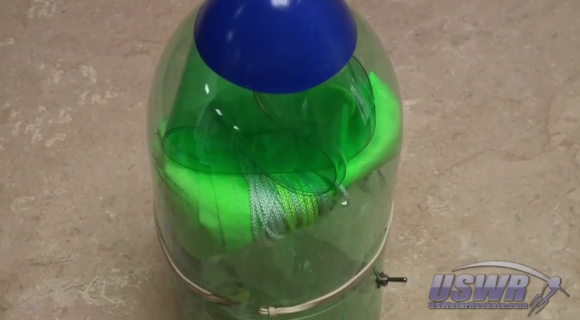
This piece of engineering is so simple and elegant, you’ll want to build a pretty serious water rocket just so you can try it out. It’s an automatic parachute deployment system that you build into the nose-cone of your rocket. The main portion of the build is made out of plastic soda bottles (2 liter size) to end up with a chamber to store the chute, as well as a friction joint that holds the thing together.
The video after the break shows a complete tutorial on how to build one of these. It starts by tracing out a sine-wave-like pattern on the wall of the bottle. The staggered tongues that are left after cutting along this line make up the friction joint. After gluing a cone (the blue thing) to the bottom of the bottle, it receives the parachute and is then slipped over another bottle that makes up the body of the rocket. The rubber band wraps around the outside of the chassis, holding those plastic tongues in place. The loose end of the rubber band is hooked around the horn of a servo motor, which can then be triggered remotely, or by using a sensor of your choosing. There is even a spring made out of a loop of plastic bottle — you can see it just on top of the chute in the image above.
Need a launching system that is as fancy as the parachute system? Here you go.














Why is this featured on hack a day. this is how these cheap rockets’ parachutes have worked for as long as there have been hobbyists.
Because this video is reasonably high quality in terms of teaching people how to make one for their own rockets. Not everyone who follows HaD has been building water rockets since birth so they’re bound to find one of today’s lucky 10,000(http://xkcd.com/1053/).
Having projects like these let educators and good parents find scientific activities they can show their children helping to create a scientifically literate public.
i made a similar device for my water bottle rocket back in school. I used a big easter egg for the nose cone and just shaved down the little lip that locks the egg closed. when it reached the peak, the rocket would start to tip sideways and the top of the egg would fall off pulling out the chute.
I did the same, even won a contest that way
nice man
Yeah… tried that, twice now. First was a 3D printed cone on top, very loose fit, That one got driven into the rest of the nosecone and I had to pry it out. About the 3rd landing, it was all bust up. Second try was a ping-pong ball sitting in a shallow cone… was actually a bulbous nose where the ball would just fall off at any significant angle. As with the first, full ballistic trajectory, up and down, burst the stupid ball and drove the dented mess into the cone, through a hold near half its diameter.
I don’t know… but I’m not getting that up, and stall at the top where things fall off. Just a beautiful ballistic curve… way up, over, and down HARD. Nothing slowing down enough to fall off. And, that’s why I ended up here wondering about parachute release mechanisms.
Still having fun though.
Kind of an underwhelming demo tape at the end. Since water rockets don’t go all that high, a video shot from the ground would have been better.
Water Rockets have gotten to 1100 feet… so far. Compressed air technology is making a come back. People are getting inventive. We’re only at it’s infancy. Where it will lead is as far as we take it. It’s kind of like being Goddard.